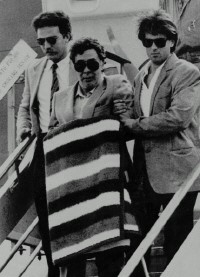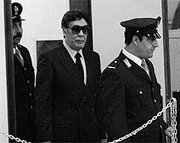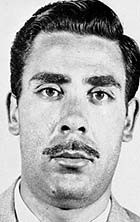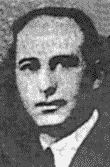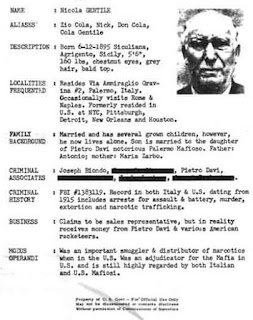Christian Democrat MEP murdered by Mafia
 |
| Salvatore 'Salvo' Lima was the most powerful Christian Democrat in Sicily |
The Christian Democrat MEP, usually known as Salvo, had long been suspected of corruption, from his days as Mayor of Palermo in the 1950s and 60s to his time as a member of the Chamber of Deputies, between 1968 and 1979, when he formed a close association with Giulio Andreotti, the three-times Italian prime minister whose rise to power was helped considerably by the support Lima was able to garner for him in Sicily.
Lima's links with the Mafia were established by a magistrates’ enquiry into his death when it was concluded that he was killed on the orders of the then all-powerful Mafia boss Salvatore ‘Toto’ Riina as an act of revenge following Lima’s failure through his connections in Rome to have sentences against 342 mafiosi accused in the so-called 'maxi-trial' of 1986-87 annulled or at least reduced.
He had allegedly promised his Cosa Nostra paymasters that he would see to it that a Supreme Court judge with a reputation for overturning sentences against suspected Mafia members was appointed prosecutor, but the position was handed instead to another judge.
 |
| Giulio Andreotti formed a close alliance |
Much of the information about Lima’s involvement with the Mafia was provided by pentiti - supergrasses - such as Tommaso Buscetta and Leonardo Messina, former mafiosi who turned state’s evidence after finding themselves disenfranchised by the ruthless purge of rival clans carried out by Riina’s Corleonesi family in the Second Mafia War of the early 1980s.
Buscetta and Messina both confirmed that Lima’s father, Vincenzo, had been a member of the Mafia.
Despite this, Salvo Lima was elected Mayor of Palermo in 1958 and again in 1965, occupying the office for a total of eight years. It was revealed later that during the construction boom in Palermo in the 50s and 60s, Lima and his fellow Christian Democrat Vito Ciancimino, who was the city’s assessor for public works, awarded hundreds of lucrative contracts to Francesco Vassallo, a builder with powerful Mafia connections.
One of them, a mafioso called Angelo La Barbera, had supported Lima’s campaign for election.
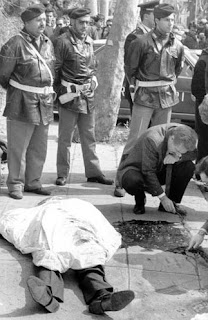 |
| Lima's body lay covered by a sheet as police looked for clues to his killing |
Lima’s election to the Chamber of Deputies in 1968 as a representative for Palermo came as a surprise, given that he was up against established politicians. It was of great benefit to Andreotti, who had much support in and around Rome but no national electoral base, that Lima was able through his influential contacts not only to place Andreotti-supporting candidates in the Sicily constituencies but also guarantee they would be elected, which gave Andreotti a much stronger powerbase in the Italian parliament than he had enjoyed previously.
When Andreotti became prime minister for the first time in 1972, it was not long before Lima had a position in government as Under-Secretary of the Budget.
He became the Member of the European Parliament for the Italian Islands in 1979 but the veneer of respectability that he took to the grave after he was murdered was seriously damaged in November 1992 when Buscetta testified before the Antimafia Commission about links between the Cosa Nostra, Lima and Andreotti.
Buscetta described Lima as “the politician to whom Cosa Nostra turned most often to resolve problems for the organisation whose solution lay in Rome."
Other witnesses, including another pentito, Gaspare Mutolo, confirmed that Lima had been ordered to "fix" the appeal of the maxi trial with Italy's Supreme Court of Cassation and had been killed because he was unable to do so.
According to Mutolo: "Lima was killed because he was the greatest symbol of that part of the political world which, after doing favours for Cosa Nostra in exchange for its votes, was no longer able to protect the interests of the organisation at the time of its most important trial."
 |
| Mondello's beautiful sandy beach is largely free to use and attracts crowds of bathers in high season. |
Mondello, where Lima lived and was murdered, is a former fishing village about 10km (6 miles) north of Palermo that has become a popular beach resort. It has a sweeping bay enclosing turquoise water and a beach of fine sand in front of a promenade lined with beautiful villas, many built in Liberty style at the start of the 20th century as summer retreats for the wealthier residents of the city. The beach, which tends to be crowded during the summer with many stretches free of charge, also has many pastel-coloured changing cabins. The nature reserve of Capo Gallo, with its white rocks and clear water, is within walking distance of Mondello.
 |
| Palermo's magnificent cathedral has a classic Sicilian mix of architectural influences from Europe and the Arab world. |
Although Palermo is widely seen by the rest of the world as a Mafia stronghold, visitors to the city would normally encounter nothing to suggest that the criminal underworld exerts any influence on daily life. The Sicilian capital, on the northern coast of the island, is a vibrant city with a wealth of beautiful architecture bearing testament to a history of northern European and Arabian influences. Typical is Palermo's majestic Cathedral of the Assumption of Virgin Mary, which includes Norman, Moorish, Gothic, Baroque and Neoclassical elements.
More reading:
Giulio Andreotti - Italy's great political survivor
The supergrass who put hundreds behind bars
Giovanni Falcone's crusade against the Mafia
Also on this day:
1752: The birth of 'father of the piano' Muzio Clementi
1881: The birth of socialite and muse Lusia Casati
1980: The death of car designer Giovanni Michelotti
Home
